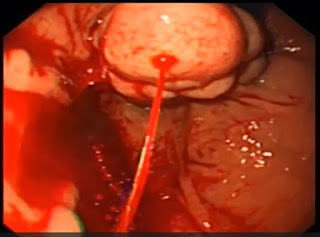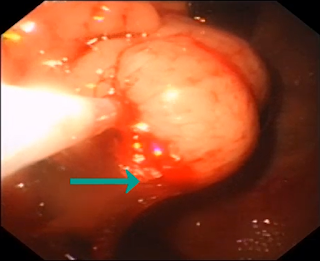Calm before the storm.
A 75-year-old man underwent an upper digestive endoscopy because of a massive attack of hematemesis five days ago. The hemoglobin level was 4 gm/ dl. A blood transfusion was given, and hemoglobin is 9 gm/dl. The patient has a history of chronic liver disease and an upper digestive endoscopy two years ago. The index endoscopy revealed gastric varices that were injected with amacrylate. The second endoscope revealed a sizeable gastric varix with a bleeding point (triangular in part 1 of the video). Just after identification, the varix begins to bleed during the endoscopy (part 2, beginning of the storm). The varix was secured with five ampoules of the amacrylate (part 3 of the video). After the injection of amacrylate, another storm (volcano) of bleeding started. The endoscopist injected the varix again with five ampoules of amacrylate. This time, you can notice the glue protruding from the bleeding point (arrow). After the endoscopy, the patient was admitted to the ICU unit and was discharged after two days.
Questions:
1- Is identifying the bleeding point in patients with bleeding gastric varices important?
2- Should the endoscopist inject at the same site of bleeding (bleeding point)
3- How can you estimate the amount of glue, and what is the maximum dose?
4- What will you do if bleeding continues after the injection?
5- What are other lines of treatment?
6- Is there a difference between managing bleeding versus non-bleeding gastric varices?
7- Can you guess the heart rate of the endoscopist?




Comments